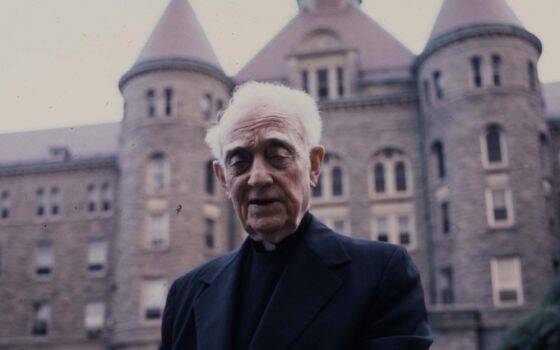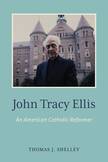The wit and wisdom of John Tracy Ellis
This essay is a Cover Story selection, a weekly feature highlighting the top picks from the editors of America Media.
Msgr. John Tracy Ellis would start each semester with the same quote: “If you lack wisdom, God can give it to you; if you lack knowledge, I can provide it; if you lack common sense, nobody can help you!”
Msgr. Thomas Shelley, a priest of the Archdiocese of New York who died last year, gives us all three in John Tracy Ellis: An American Catholic Reformer, a well-documented yet very readable biography of the “dean” of American Catholic history. Ever faithful to his mentor, Shelley would admit that he perhaps lacks the distance and impartiality called for in a scholarly biography, as he himself was a student and friend of Ellis. Yet he gives us a fair and thorough treatment without becoming hagiographic—Ellis would cringe at such!—of this unforgettable and most influential priest, churchman and historian.
History is akin to gossip with footnotes, Ellis would insist.
Shelley’s own track record of writings—especially his Paul J. Hallinan: First Archbishop of Atlanta, his history of Fordham University and his history of St. Joseph’s Seminary, to name but three from a lengthy list—displays Ellis’s influence not only upon him, but on a distinguished and significant number of other historians trained by “the dean.” Ellis is usually listed in the trinity of normative American church historians, along with John Gilmary Shea and Peter Keenan Guilday, but Ellis had no peer.
That he was born in 1905 in a Saturday Evening Post cover town in the Midwest, Seneca, Ill., gave Ellis the impeccable manners, loyalty to family and friends, sense of responsibility and energetic work that the author often praises. From the start, through the first three and a half decades of his life, his priority was learning. He was not ordained a priest until 1938 (for the Diocese of Winona, though he would later be incardinated into the Archdiocese of Washington). An eager reader, he especially savored his years at St. Viator College, a combination high school-college in central Illinois run by the Viatorians.
While ever witty and sociable, Ellis was, as well, deeply devout. Even as a youth and a student, he depended on a regimen, fortified by Viatorian tradition, of frequent Mass and Holy Communion, regular confession, and a steady habit of prayer and spiritual reading. He came under the tutelage of priests who encouraged him in piety and learning, especially the Viatorian and historian Edward Cardinal, and other priests who would later include even Msgr. Fulton J. Sheen, with whom he lived and for whom he served as a lay secretary in the 1930s in Washington, D.C.
With these priests, he would often seek help in discerning a possible vocation to the priesthood, a decision always postponed because of his passion for learning and a longing to teach and undertake serious research. Thank God he eventually discovered the two not to be exclusive.
Shelley colorfully traces Ellis’s multiple teaching assignments, taking him from The Catholic University of America to Kansas, Illinois, Minnesota, Texas and California, always at small Catholic colleges run by religious orders. They all left him restless. His yearning from the start of his teaching was to return full time to C.U.A., where he had earned his doctorate under Msgr. Peter Guilday. Guilday’s masterful biographies of John Carroll and John England, plus his volume on the Councils of Baltimore, had a deep impact on the young Ellis, especially Guilday’s insistence on depending upon original sources.
Ellis’s own studies, as well as his teaching at these multiple tiny Catholic colleges, gave him more than immense learning. They prompted in him a stinging criticism of the church’s noble yet less-than-rigorous “higher education.” For one, he lamented from the start that there were far too many church-sponsored colleges, all of which were underfunded, with professors both underpaid and not given enough time for serious research. Far better, Ellis would constantly plead, for the church to have a few well-financed, first-rate colleges and universities than a plethora of mediocre ones. While he deeply admired the mission of the church in higher education, and respected highly the commitment of religious orders, especially of women, he felt this multiplication counterproductive, a criticism he extended to seminaries as well. Fewer but better, he argued his entire life.
Ellis also mourned the reduction of scholarly church history to defensive apologetics. Throughout his life he would cringe at well-intentioned bishops, and even fellow authors, who felt the aim of church history was to edify, never shock, God’s people. “We show the mystical body of Christ, warts and all!” he would thunder to generations of students. Shelley highlights Ellis’s towering esteem for two leaders who encouraged historians never to evade the facts, and to place the narrative of truth, even when it hurt, as the historian’s indispensable task: Pope Leo XIII and Cardinal John Henry Newman.
This gusto for the truth, Shelley correctly notes, gave Ellis’s classroom pedagogy and numerous writings a tantalizing style. History is akin to gossip with footnotes, Ellis would insist.
Ellis was also convinced that scholars, and, for that matter, all loyal Catholics, should not feel compelled to let their love for the church scare them into avoiding any honest fault-finding. This was especially poignant in an era of “ghetto Catholicism,” when the church, especially in the United States, was termed “a state within a state” with a tight, cohesive culture that spawned a sense of defensiveness among Catholics, and led to critics, even sincere ones, being looked upon as disloyal.
These lifelong convictions came to national attention when, in May 1955, Ellis, then a full professor at C.U.A., editor of the prestigious Catholic Historical Review and author of the widely lauded two-volume biography of Cardinal James Gibbons (to this day unfailingly termed “magisterial”), delivered a lecture in Chicago on anti-intellectualism in American Catholic life. It became a bombshell.
“We show the mystical body of Christ, warts and all!” Ellis would thunder to generations of students.
Why, Ellis asked, was a church so renowned in America for its hospitals, charities, vocations, parochial vitality, strong families, patriotism, growth in numbers and rising prosperity so lackluster and stagnant in producing top-rate intellectuals? While he gave some reasons—the struggling immigrant status of Catholics, their economic woes, their penchant for action and pragmatism over advanced learning—none of these, persuasively argued Ellis, could erase the fact that the church’s moribund intellectual life in America was a detriment to the Catholic future in the republic, and unworthy of a church that was the stalwart of learning and culture in Europe.
This lecture, later published in Thought, marked Ellis as a “liberal,” a brand he later smiled at, as he considered himself quite old-fashioned; thus the title of Shelley’s biography, terming Ellis a reformer. Ever careful, Shelley usually uses the adjective “balanced” when describing Ellis’s advocacy and liberalism.
As the author shows, there is no doubt that Ellis was a liberal in the Newman tradition. He had a strong “commitment to truth” (the title of what might be Ellis’s most moving book); he had an unwillingness to be muted on legitimate, if always reverent, criticism of the church; and he dared to step outside the obligatory defensiveness toward the dominant culture, and even to cooperate with and sympathize with some developments in the modern world, such as civil rights and issues of justice and peace.
This liberalism became even more evident in his embrace of the reforms of Pope John XXIII and the Second Vatican Council, and in his frequent jabs at Rome and the American bishops for being too slow and stumbling in the council’s implementation. This “reformer” would advocate for much more involvement in the church for the laity, and for priests in the choice of bishops. He was not shy in complaining aboutprelates who were aristocratic, unapproachable and thought themselves above criticism.
A large part of Ellis’s fondness for the council was its affirmation of religious freedom, which he saw as a vindication of the American experiment, cherished and promoted by the church on these shores. Shelley’s treatment of Ellis’s friendship with, cooperation with and encouragement given to John Courtney Murray, S.J., the American Jesuit renowned (at much personal cost) as the advocate for the American brand of religious freedom, is especially new and illuminative.
Yet Shelley skillfully shows that Ellis was far too complicated to be fully understood only as a liberal. Close to him personally as he was, he knew Ellis to be an old-fashioned gentleman, heartily in love with the church—“warts and all!”—pious in his spiritual regimen, polite and well mannered, loyal to church teaching on faith and morals, who had no patience at all with frenzies to the right or left. In one class, when a student asked his preference for The Wanderer or The National Catholic Reporter, Ellis shouted out, “A curse on both their houses!”
Why, Ellis asked, was a church so renowned in America for its growth in numbers and rising prosperity so lackluster and stagnant in producing top-rate intellectuals?
And while he began to cautiously welcome reforms on higher education—lay government, academic freedom and the downsizing in the numbers of smaller, struggling Catholic colleges—he could be heard lamenting the de-emphasis on the traditional promotion of the classics, philosophy, theology, history, languages and literature, fearing Catholic universities were losing some of their uniqueness, eager to become “Harvards with incense.”
Shelley is not shy about Ellis’s venial sins: that he favored excessively the institutional, or episcopal biography style of church history, instead of “history from below”; that he could have moments of tantrum, in speech and writing, against those “not his cup of tea”; and that he was easily hurt by those he believed were friends.
As is clear, this reviewer is obviously high on this book, while confessing a friendship with both the subject and the author. Mistakes? I searched for them, and, with the exception of the dates of the tenure of Archbishop Jean Jadot as apostolic delegate here in the United States, was unable to find any. Shelley does sometimes repeat himself: We hardly needed 10 mentions of Ellis’s description of Msgr. George Higgins as “the best informed priest in America,” true as it may have been. Shelley can also be too knee-jerk in his dependence upon terms such as progressive and liberal versus ultraconservative and reactionary, with the first group the heroes and the latter the villains.
If you were fortunate enough to have known, studied under, read or listened to John Tracy Ellis, you will find yourself smiling, sometimes tearing up, and enthusiastically nodding in agreement with Shelley’s book. If you are simply interested in a deeper appreciation of 20th-century Catholicism in America, you can’t go wrong with this volume.
This article also appeared in print, under the headline “The Dean of Catholic History,” in the September 2023, issue.











